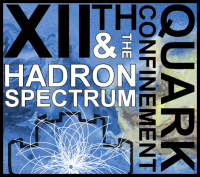Speaker
Description
We discuss how the thermal ground state of an SU(2) Yang-Mills theory in its deconfining phase is composed of Harrington-Shepard (HS) (anti)calorons that are subject to deformation due to overlapping and static peripheries. The construction first performs a spatial coarse-graining over the central regions for HS (anti)calorons in isolation -- a unique process which determines the temperature and Yang-Mills scale dependence of an inert adjoint scalar field -- and then uses an adiabatic argument to quantify the effect of overlap by slowly
letting (protected) centers approach one another spatially (dense packing). The resulting effective thermal quantum field theory's equation of motion possess a ground-state
solution which summarizes this physics collectively and breaks the gauge symmetry SU(2) down to U(1). We show that this ground state carries densities of electric/magnetic dipoles that are associated with a temperature independent permittivity/permeability.
Summary
We discuss how the thermal ground state of an SU(2) Yang-Mills theory in its deconfining phase is composed of Harrington-Shepard (HS) (anti)calorons that are subject to deformation due to overlapping and static peripheries. The construction first performs a spatial coarse-graining over the central regions for HS (anti)calorons in isolation -- a unique process which determines the temperature and Yang-Mills scale dependence of an inert adjoint scalar field -- and then uses an adiabatic argument to quantify the effect of overlap by slowly
letting (protected) centers approach one another spatially (dense packing). The resulting effective thermal quantum field theory's equation of motion possess a ground-state
solution which summarizes this physics collectively and breaks the gauge symmetry SU(2) down to U(1). We show that this ground state carries densities of electric/magnetic dipoles that are associated with a temperature independent permittivity/permeability.
